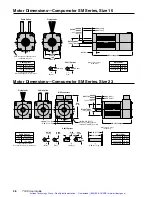
➁
Installation
35
Resonance Issues
A coupler that is too flexible may cause a motor to overshoot its commanded position.
When the encoder sends a position feedback signal, the controller will command a
correction move in the opposite direction. If the resonant frequency of the system is too low
(too flexible), the motor may overshoot again and again. In extreme cases, the system could
become an oscillator.
To solve resonance problems, increase the mechanical stiffness of the system to raise the
resonant frequency so that it no longer causes a problem.
If you use a servo as a direct replacement for a step motor, you may need to modify your
mechanical coupling system to reduce resonance. For example, we recommend using a
bellows-style coupler with servo motors, rather than the helical-style coupler that is often
used with step motors. Helical couplers are often too flexible, with resonant frequencies
that can cause problems. Bellows couplers are stiffer, and perform better in servo systems.
Tuning – TQ10 Torque Drive
The TQ10 Torque Drive requires no tuning adjustments. See your controller’s User Guide
for instructions on controller tuning adjustments.
If you use a high performance motor (peak current rating greater than three times the
continuous current rating), such as Compumotor’s SM and NeoMetric Series servo motors,
see the
Special Considerations
section below.
Special Considerations when Tuning with SM and N Series Motors
When using a Compumotor SM or NeoMetric Series motor, or other high performance
servo motor, be careful not to overheat the motor while tuning your system. If you acciden-
tally choose tuning gains that cause motor oscillations or instability, excess motor current
can quickly overheat and damage the motor—even before the thermostat can trigger the
motor overtemperature circuit.
CAUTION
For initial tuning with an SM or NeoMetric motor, set peak current DIP switches at twice the
motor’s continuous rated current, or less. Otherwise, high peak currents during instability
may cause motor overheating and damage.
To avoid damage, we recommend a tuning procedure that may differ from methods you
have used before. Instability sometimes
does occur
during tuning; to avoid the damaging
currents that instability can cause, reduce the peak current
before
you begin the tuning
process. Then, as you refine your tuning values, you can gradually increase peak current.
Details of this procedure are listed below.
Because you will start with reduced peak current, at first the motor may not be able to make
the move called for in your application. The best way to test the system’s response under
this reduced current condition is to command a short test move, and observe the results.
After you change current settings, adjust tuning gains, or command a move, closely monitor
the motor. If there is any sign of uncontrolled instability, quickly disable the drive to avoid
motor damage. The fastest, most reliable way to disable the drive is with a normally-closed
switch connected in series with the
ENABLE IN
input.
Artisan Technology Group - Quality Instrumentation ... Guaranteed | (888) 88-SOURCE | www.artisantg.com
















































